Business Strategy Analysis of Aldi: A Comprehensive Report
VerifiedAdded on 2020/07/23
|26
|8693
|40
Report
AI Summary
This report provides a comprehensive analysis of Aldi's business strategy. It begins with an introduction to business strategy and then delves into Aldi's mission, vision, objectives, goals, and core competencies. The report examines the factors Aldi considers when formulating its strategic plans, including competition, customer needs, and resources. It also explores the usefulness of the BCG matrix in developing strategic planning. Furthermore, the report includes an organizational and environmental audit of Aldi and suggests a new strategy. It analyzes the appropriateness of a suitable strategy, justifies the selected strategy, and discusses the role of personnel and resource requirements for implementation, including the contribution of SMART targets. The report concludes with a summary of findings and recommendations.
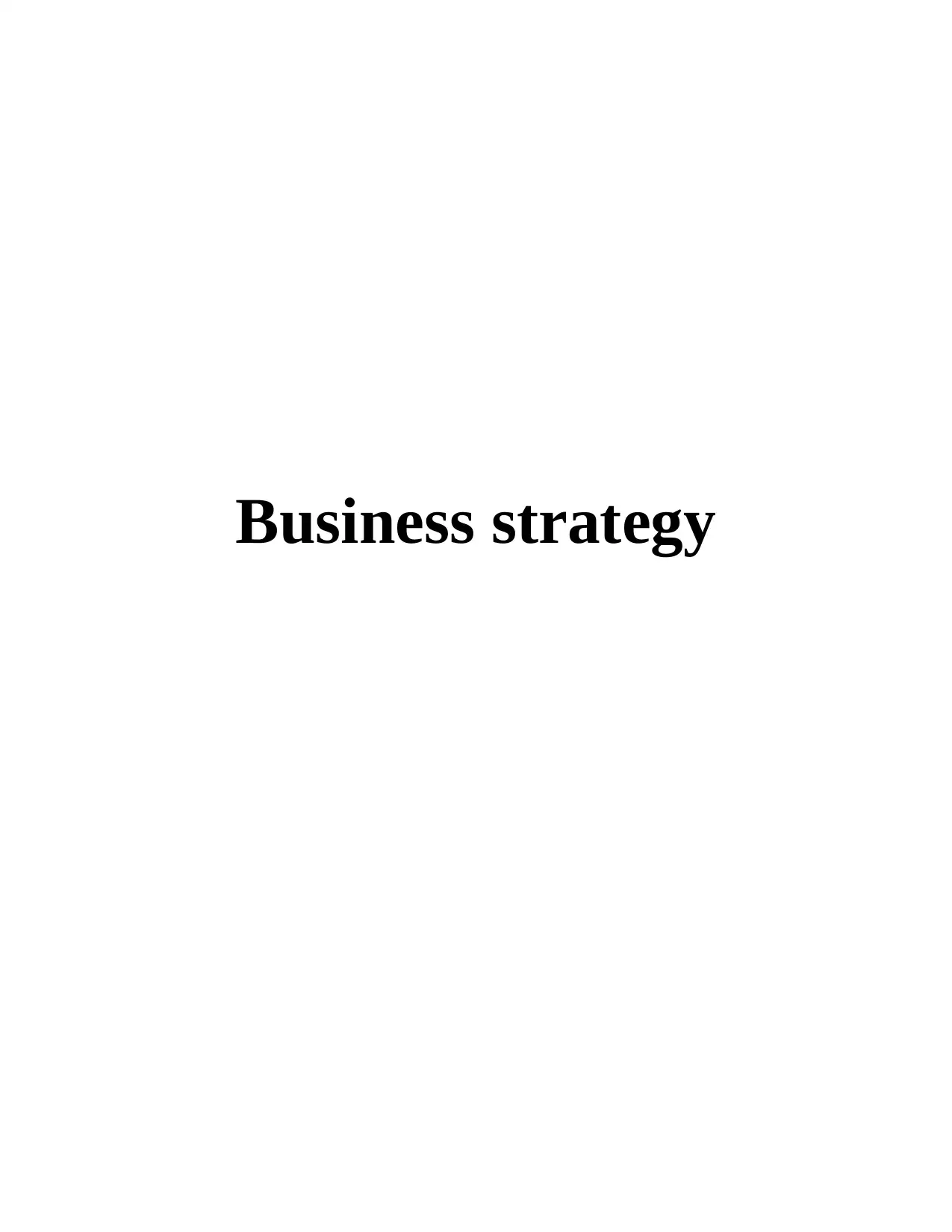
Business strategy
Paraphrase This Document
Need a fresh take? Get an instant paraphrase of this document with our AI Paraphraser
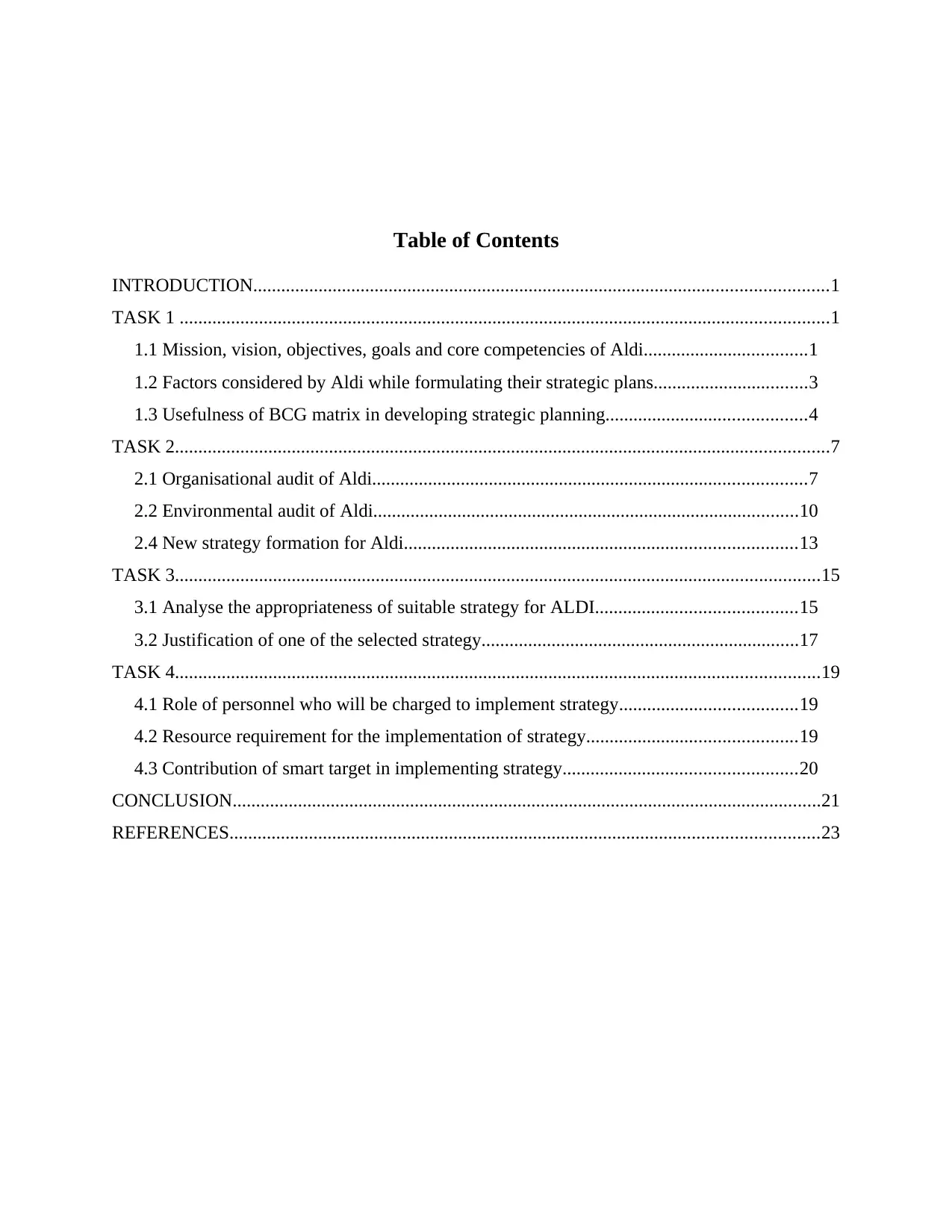
Table of Contents
INTRODUCTION...........................................................................................................................1
TASK 1 ...........................................................................................................................................1
1.1 Mission, vision, objectives, goals and core competencies of Aldi...................................1
1.2 Factors considered by Aldi while formulating their strategic plans.................................3
1.3 Usefulness of BCG matrix in developing strategic planning...........................................4
TASK 2............................................................................................................................................7
2.1 Organisational audit of Aldi.............................................................................................7
2.2 Environmental audit of Aldi...........................................................................................10
2.4 New strategy formation for Aldi....................................................................................13
TASK 3..........................................................................................................................................15
3.1 Analyse the appropriateness of suitable strategy for ALDI...........................................15
3.2 Justification of one of the selected strategy....................................................................17
TASK 4..........................................................................................................................................19
4.1 Role of personnel who will be charged to implement strategy......................................19
4.2 Resource requirement for the implementation of strategy.............................................19
4.3 Contribution of smart target in implementing strategy..................................................20
CONCLUSION..............................................................................................................................21
REFERENCES..............................................................................................................................23
INTRODUCTION...........................................................................................................................1
TASK 1 ...........................................................................................................................................1
1.1 Mission, vision, objectives, goals and core competencies of Aldi...................................1
1.2 Factors considered by Aldi while formulating their strategic plans.................................3
1.3 Usefulness of BCG matrix in developing strategic planning...........................................4
TASK 2............................................................................................................................................7
2.1 Organisational audit of Aldi.............................................................................................7
2.2 Environmental audit of Aldi...........................................................................................10
2.4 New strategy formation for Aldi....................................................................................13
TASK 3..........................................................................................................................................15
3.1 Analyse the appropriateness of suitable strategy for ALDI...........................................15
3.2 Justification of one of the selected strategy....................................................................17
TASK 4..........................................................................................................................................19
4.1 Role of personnel who will be charged to implement strategy......................................19
4.2 Resource requirement for the implementation of strategy.............................................19
4.3 Contribution of smart target in implementing strategy..................................................20
CONCLUSION..............................................................................................................................21
REFERENCES..............................................................................................................................23
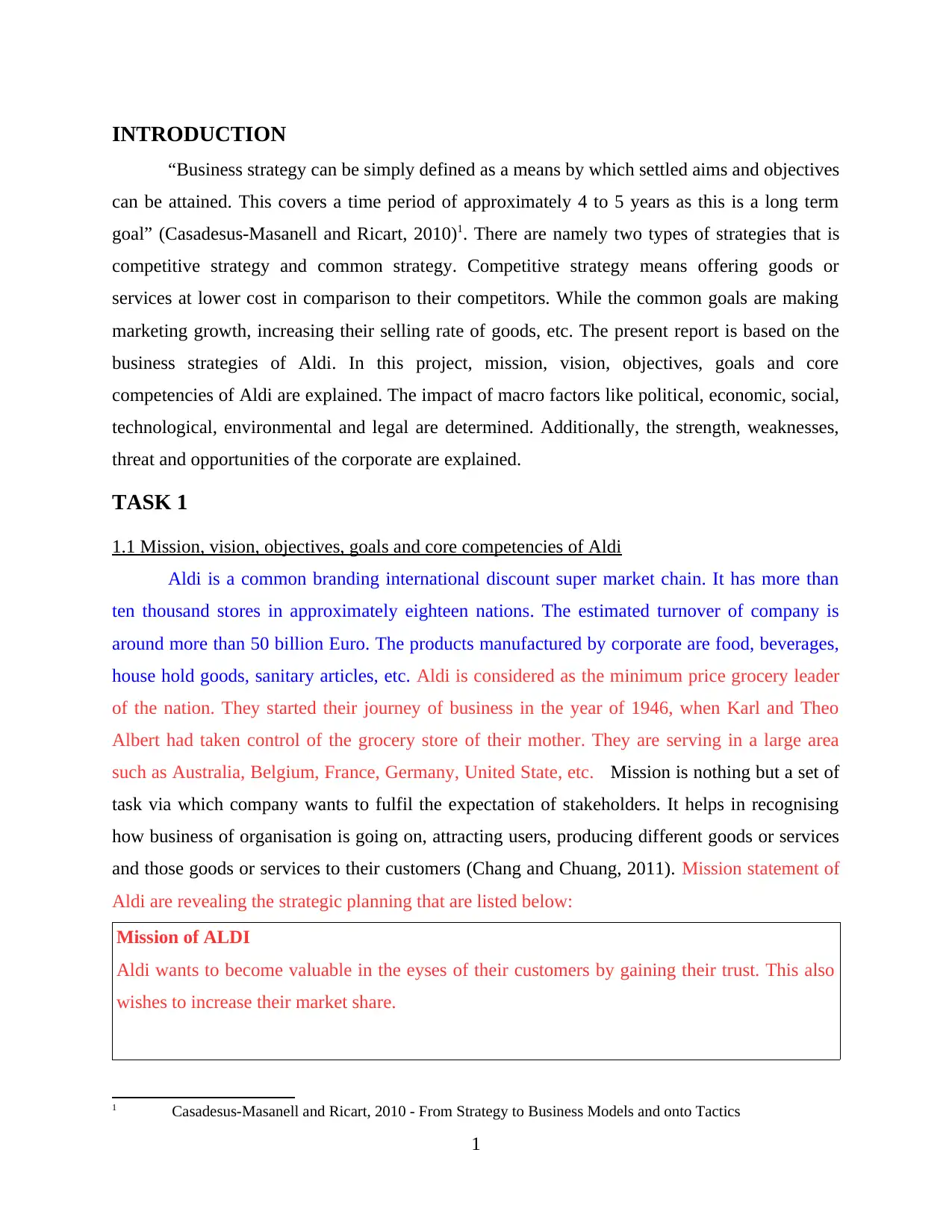
INTRODUCTION
“Business strategy can be simply defined as a means by which settled aims and objectives
can be attained. This covers a time period of approximately 4 to 5 years as this is a long term
goal” (Casadesus-Masanell and Ricart, 2010)1. There are namely two types of strategies that is
competitive strategy and common strategy. Competitive strategy means offering goods or
services at lower cost in comparison to their competitors. While the common goals are making
marketing growth, increasing their selling rate of goods, etc. The present report is based on the
business strategies of Aldi. In this project, mission, vision, objectives, goals and core
competencies of Aldi are explained. The impact of macro factors like political, economic, social,
technological, environmental and legal are determined. Additionally, the strength, weaknesses,
threat and opportunities of the corporate are explained.
TASK 1
1.1 Mission, vision, objectives, goals and core competencies of Aldi
Aldi is a common branding international discount super market chain. It has more than
ten thousand stores in approximately eighteen nations. The estimated turnover of company is
around more than 50 billion Euro. The products manufactured by corporate are food, beverages,
house hold goods, sanitary articles, etc. Aldi is considered as the minimum price grocery leader
of the nation. They started their journey of business in the year of 1946, when Karl and Theo
Albert had taken control of the grocery store of their mother. They are serving in a large area
such as Australia, Belgium, France, Germany, United State, etc. Mission is nothing but a set of
task via which company wants to fulfil the expectation of stakeholders. It helps in recognising
how business of organisation is going on, attracting users, producing different goods or services
and those goods or services to their customers (Chang and Chuang, 2011). Mission statement of
Aldi are revealing the strategic planning that are listed below:
Mission of ALDI
Aldi wants to become valuable in the eyses of their customers by gaining their trust. This also
wishes to increase their market share.
1 Casadesus-Masanell and Ricart, 2010 - From Strategy to Business Models and onto Tactics
1
“Business strategy can be simply defined as a means by which settled aims and objectives
can be attained. This covers a time period of approximately 4 to 5 years as this is a long term
goal” (Casadesus-Masanell and Ricart, 2010)1. There are namely two types of strategies that is
competitive strategy and common strategy. Competitive strategy means offering goods or
services at lower cost in comparison to their competitors. While the common goals are making
marketing growth, increasing their selling rate of goods, etc. The present report is based on the
business strategies of Aldi. In this project, mission, vision, objectives, goals and core
competencies of Aldi are explained. The impact of macro factors like political, economic, social,
technological, environmental and legal are determined. Additionally, the strength, weaknesses,
threat and opportunities of the corporate are explained.
TASK 1
1.1 Mission, vision, objectives, goals and core competencies of Aldi
Aldi is a common branding international discount super market chain. It has more than
ten thousand stores in approximately eighteen nations. The estimated turnover of company is
around more than 50 billion Euro. The products manufactured by corporate are food, beverages,
house hold goods, sanitary articles, etc. Aldi is considered as the minimum price grocery leader
of the nation. They started their journey of business in the year of 1946, when Karl and Theo
Albert had taken control of the grocery store of their mother. They are serving in a large area
such as Australia, Belgium, France, Germany, United State, etc. Mission is nothing but a set of
task via which company wants to fulfil the expectation of stakeholders. It helps in recognising
how business of organisation is going on, attracting users, producing different goods or services
and those goods or services to their customers (Chang and Chuang, 2011). Mission statement of
Aldi are revealing the strategic planning that are listed below:
Mission of ALDI
Aldi wants to become valuable in the eyses of their customers by gaining their trust. This also
wishes to increase their market share.
1 Casadesus-Masanell and Ricart, 2010 - From Strategy to Business Models and onto Tactics
1
⊘ This is a preview!⊘
Do you want full access?
Subscribe today to unlock all pages.

Trusted by 1+ million students worldwide
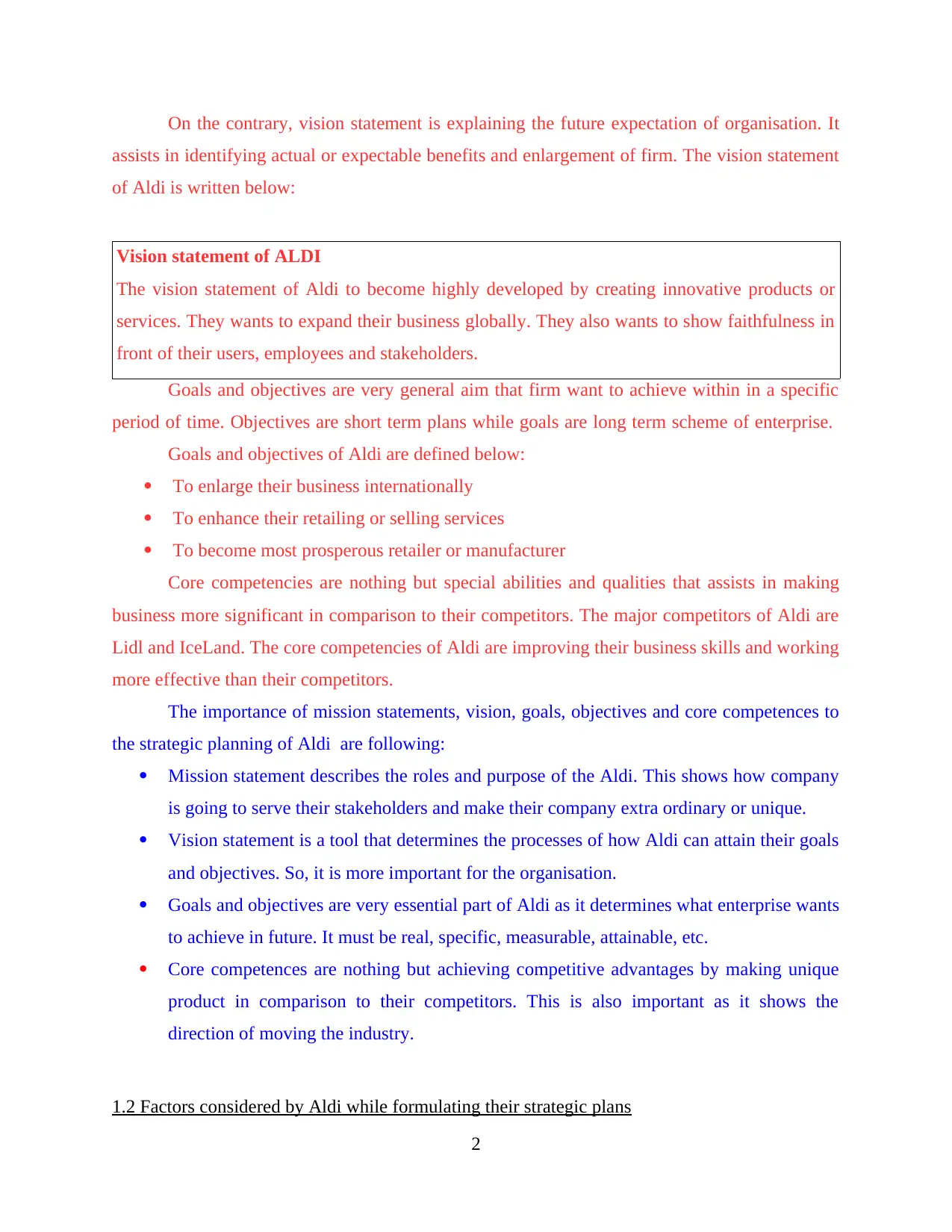
On the contrary, vision statement is explaining the future expectation of organisation. It
assists in identifying actual or expectable benefits and enlargement of firm. The vision statement
of Aldi is written below:
Vision statement of ALDI
The vision statement of Aldi to become highly developed by creating innovative products or
services. They wants to expand their business globally. They also wants to show faithfulness in
front of their users, employees and stakeholders.
Goals and objectives are very general aim that firm want to achieve within in a specific
period of time. Objectives are short term plans while goals are long term scheme of enterprise.
Goals and objectives of Aldi are defined below:
To enlarge their business internationally
To enhance their retailing or selling services
To become most prosperous retailer or manufacturer
Core competencies are nothing but special abilities and qualities that assists in making
business more significant in comparison to their competitors. The major competitors of Aldi are
Lidl and IceLand. The core competencies of Aldi are improving their business skills and working
more effective than their competitors.
The importance of mission statements, vision, goals, objectives and core competences to
the strategic planning of Aldi are following:
Mission statement describes the roles and purpose of the Aldi. This shows how company
is going to serve their stakeholders and make their company extra ordinary or unique.
Vision statement is a tool that determines the processes of how Aldi can attain their goals
and objectives. So, it is more important for the organisation.
Goals and objectives are very essential part of Aldi as it determines what enterprise wants
to achieve in future. It must be real, specific, measurable, attainable, etc.
Core competences are nothing but achieving competitive advantages by making unique
product in comparison to their competitors. This is also important as it shows the
direction of moving the industry.
1.2 Factors considered by Aldi while formulating their strategic plans
2
assists in identifying actual or expectable benefits and enlargement of firm. The vision statement
of Aldi is written below:
Vision statement of ALDI
The vision statement of Aldi to become highly developed by creating innovative products or
services. They wants to expand their business globally. They also wants to show faithfulness in
front of their users, employees and stakeholders.
Goals and objectives are very general aim that firm want to achieve within in a specific
period of time. Objectives are short term plans while goals are long term scheme of enterprise.
Goals and objectives of Aldi are defined below:
To enlarge their business internationally
To enhance their retailing or selling services
To become most prosperous retailer or manufacturer
Core competencies are nothing but special abilities and qualities that assists in making
business more significant in comparison to their competitors. The major competitors of Aldi are
Lidl and IceLand. The core competencies of Aldi are improving their business skills and working
more effective than their competitors.
The importance of mission statements, vision, goals, objectives and core competences to
the strategic planning of Aldi are following:
Mission statement describes the roles and purpose of the Aldi. This shows how company
is going to serve their stakeholders and make their company extra ordinary or unique.
Vision statement is a tool that determines the processes of how Aldi can attain their goals
and objectives. So, it is more important for the organisation.
Goals and objectives are very essential part of Aldi as it determines what enterprise wants
to achieve in future. It must be real, specific, measurable, attainable, etc.
Core competences are nothing but achieving competitive advantages by making unique
product in comparison to their competitors. This is also important as it shows the
direction of moving the industry.
1.2 Factors considered by Aldi while formulating their strategic plans
2
Paraphrase This Document
Need a fresh take? Get an instant paraphrase of this document with our AI Paraphraser
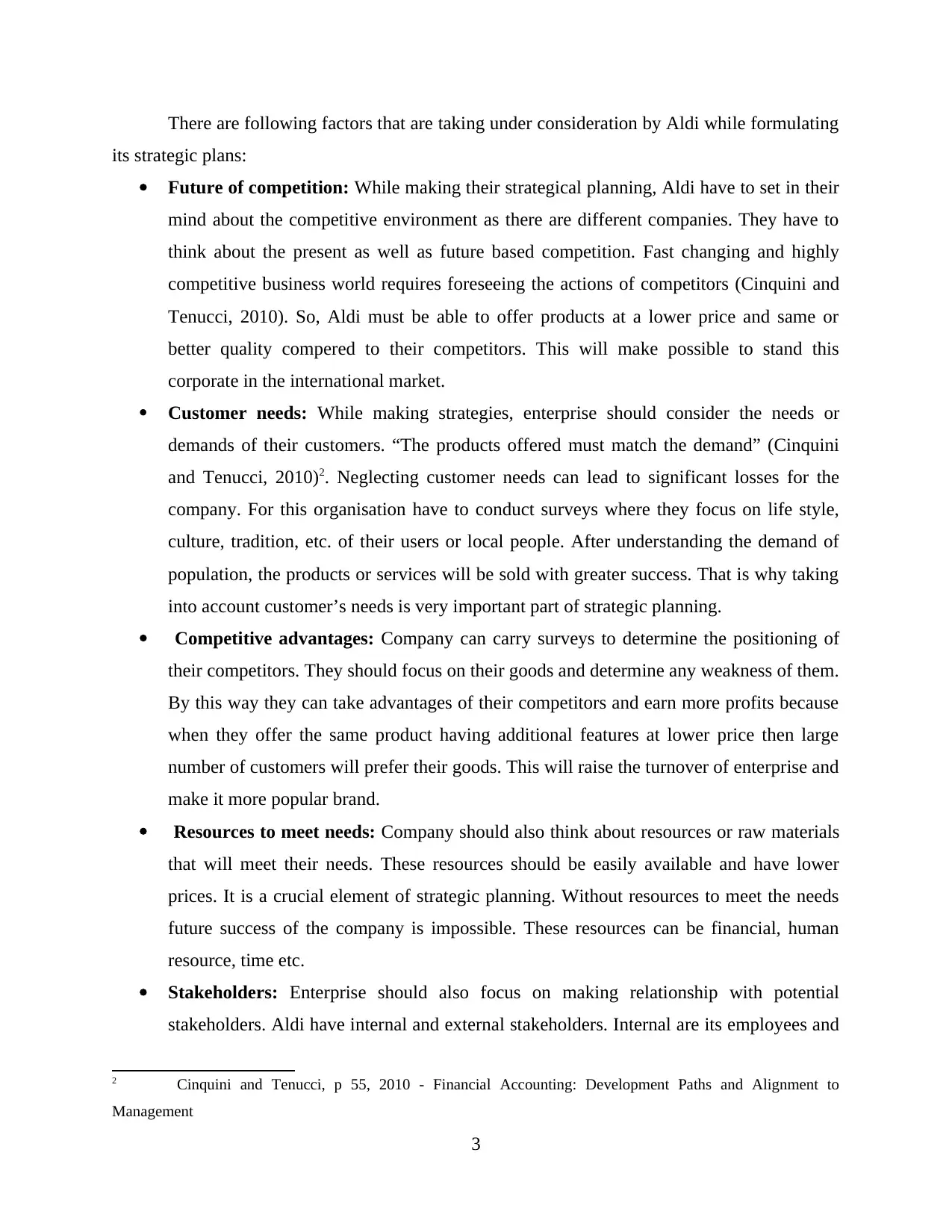
There are following factors that are taking under consideration by Aldi while formulating
its strategic plans:
Future of competition: While making their strategical planning, Aldi have to set in their
mind about the competitive environment as there are different companies. They have to
think about the present as well as future based competition. Fast changing and highly
competitive business world requires foreseeing the actions of competitors (Cinquini and
Tenucci, 2010). So, Aldi must be able to offer products at a lower price and same or
better quality compered to their competitors. This will make possible to stand this
corporate in the international market.
Customer needs: While making strategies, enterprise should consider the needs or
demands of their customers. “The products offered must match the demand” (Cinquini
and Tenucci, 2010)2. Neglecting customer needs can lead to significant losses for the
company. For this organisation have to conduct surveys where they focus on life style,
culture, tradition, etc. of their users or local people. After understanding the demand of
population, the products or services will be sold with greater success. That is why taking
into account customer’s needs is very important part of strategic planning.
Competitive advantages: Company can carry surveys to determine the positioning of
their competitors. They should focus on their goods and determine any weakness of them.
By this way they can take advantages of their competitors and earn more profits because
when they offer the same product having additional features at lower price then large
number of customers will prefer their goods. This will raise the turnover of enterprise and
make it more popular brand.
Resources to meet needs: Company should also think about resources or raw materials
that will meet their needs. These resources should be easily available and have lower
prices. It is a crucial element of strategic planning. Without resources to meet the needs
future success of the company is impossible. These resources can be financial, human
resource, time etc.
Stakeholders: Enterprise should also focus on making relationship with potential
stakeholders. Aldi have internal and external stakeholders. Internal are its employees and
2 Cinquini and Tenucci, p 55, 2010 - Financial Accounting: Development Paths and Alignment to
Management
3
its strategic plans:
Future of competition: While making their strategical planning, Aldi have to set in their
mind about the competitive environment as there are different companies. They have to
think about the present as well as future based competition. Fast changing and highly
competitive business world requires foreseeing the actions of competitors (Cinquini and
Tenucci, 2010). So, Aldi must be able to offer products at a lower price and same or
better quality compered to their competitors. This will make possible to stand this
corporate in the international market.
Customer needs: While making strategies, enterprise should consider the needs or
demands of their customers. “The products offered must match the demand” (Cinquini
and Tenucci, 2010)2. Neglecting customer needs can lead to significant losses for the
company. For this organisation have to conduct surveys where they focus on life style,
culture, tradition, etc. of their users or local people. After understanding the demand of
population, the products or services will be sold with greater success. That is why taking
into account customer’s needs is very important part of strategic planning.
Competitive advantages: Company can carry surveys to determine the positioning of
their competitors. They should focus on their goods and determine any weakness of them.
By this way they can take advantages of their competitors and earn more profits because
when they offer the same product having additional features at lower price then large
number of customers will prefer their goods. This will raise the turnover of enterprise and
make it more popular brand.
Resources to meet needs: Company should also think about resources or raw materials
that will meet their needs. These resources should be easily available and have lower
prices. It is a crucial element of strategic planning. Without resources to meet the needs
future success of the company is impossible. These resources can be financial, human
resource, time etc.
Stakeholders: Enterprise should also focus on making relationship with potential
stakeholders. Aldi have internal and external stakeholders. Internal are its employees and
2 Cinquini and Tenucci, p 55, 2010 - Financial Accounting: Development Paths and Alignment to
Management
3
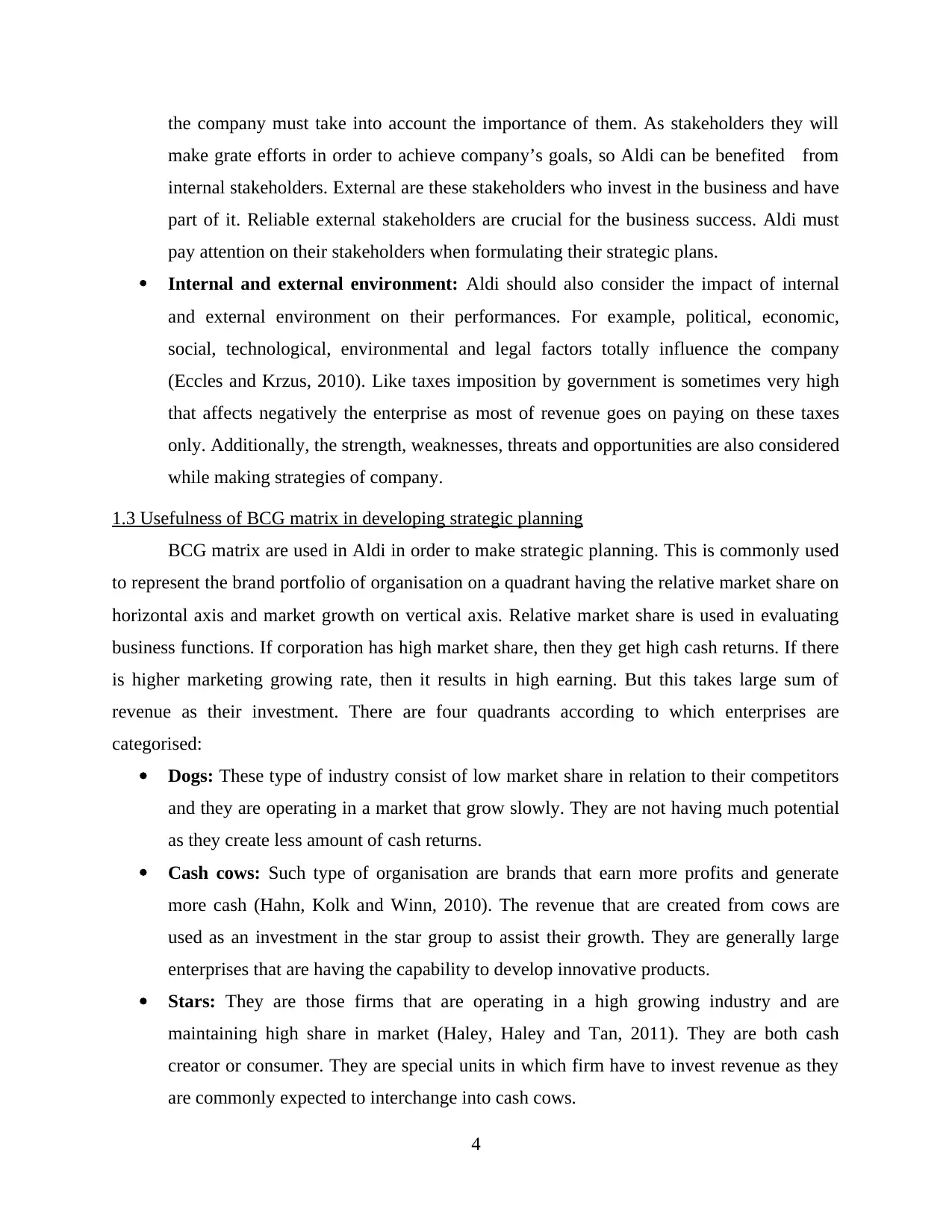
the company must take into account the importance of them. As stakeholders they will
make grate efforts in order to achieve company’s goals, so Aldi can be benefited from
internal stakeholders. External are these stakeholders who invest in the business and have
part of it. Reliable external stakeholders are crucial for the business success. Aldi must
pay attention on their stakeholders when formulating their strategic plans.
Internal and external environment: Aldi should also consider the impact of internal
and external environment on their performances. For example, political, economic,
social, technological, environmental and legal factors totally influence the company
(Eccles and Krzus, 2010). Like taxes imposition by government is sometimes very high
that affects negatively the enterprise as most of revenue goes on paying on these taxes
only. Additionally, the strength, weaknesses, threats and opportunities are also considered
while making strategies of company.
1.3 Usefulness of BCG matrix in developing strategic planning
BCG matrix are used in Aldi in order to make strategic planning. This is commonly used
to represent the brand portfolio of organisation on a quadrant having the relative market share on
horizontal axis and market growth on vertical axis. Relative market share is used in evaluating
business functions. If corporation has high market share, then they get high cash returns. If there
is higher marketing growing rate, then it results in high earning. But this takes large sum of
revenue as their investment. There are four quadrants according to which enterprises are
categorised:
Dogs: These type of industry consist of low market share in relation to their competitors
and they are operating in a market that grow slowly. They are not having much potential
as they create less amount of cash returns.
Cash cows: Such type of organisation are brands that earn more profits and generate
more cash (Hahn, Kolk and Winn, 2010). The revenue that are created from cows are
used as an investment in the star group to assist their growth. They are generally large
enterprises that are having the capability to develop innovative products.
Stars: They are those firms that are operating in a high growing industry and are
maintaining high share in market (Haley, Haley and Tan, 2011). They are both cash
creator or consumer. They are special units in which firm have to invest revenue as they
are commonly expected to interchange into cash cows.
4
make grate efforts in order to achieve company’s goals, so Aldi can be benefited from
internal stakeholders. External are these stakeholders who invest in the business and have
part of it. Reliable external stakeholders are crucial for the business success. Aldi must
pay attention on their stakeholders when formulating their strategic plans.
Internal and external environment: Aldi should also consider the impact of internal
and external environment on their performances. For example, political, economic,
social, technological, environmental and legal factors totally influence the company
(Eccles and Krzus, 2010). Like taxes imposition by government is sometimes very high
that affects negatively the enterprise as most of revenue goes on paying on these taxes
only. Additionally, the strength, weaknesses, threats and opportunities are also considered
while making strategies of company.
1.3 Usefulness of BCG matrix in developing strategic planning
BCG matrix are used in Aldi in order to make strategic planning. This is commonly used
to represent the brand portfolio of organisation on a quadrant having the relative market share on
horizontal axis and market growth on vertical axis. Relative market share is used in evaluating
business functions. If corporation has high market share, then they get high cash returns. If there
is higher marketing growing rate, then it results in high earning. But this takes large sum of
revenue as their investment. There are four quadrants according to which enterprises are
categorised:
Dogs: These type of industry consist of low market share in relation to their competitors
and they are operating in a market that grow slowly. They are not having much potential
as they create less amount of cash returns.
Cash cows: Such type of organisation are brands that earn more profits and generate
more cash (Hahn, Kolk and Winn, 2010). The revenue that are created from cows are
used as an investment in the star group to assist their growth. They are generally large
enterprises that are having the capability to develop innovative products.
Stars: They are those firms that are operating in a high growing industry and are
maintaining high share in market (Haley, Haley and Tan, 2011). They are both cash
creator or consumer. They are special units in which firm have to invest revenue as they
are commonly expected to interchange into cash cows.
4
⊘ This is a preview!⊘
Do you want full access?
Subscribe today to unlock all pages.

Trusted by 1+ million students worldwide
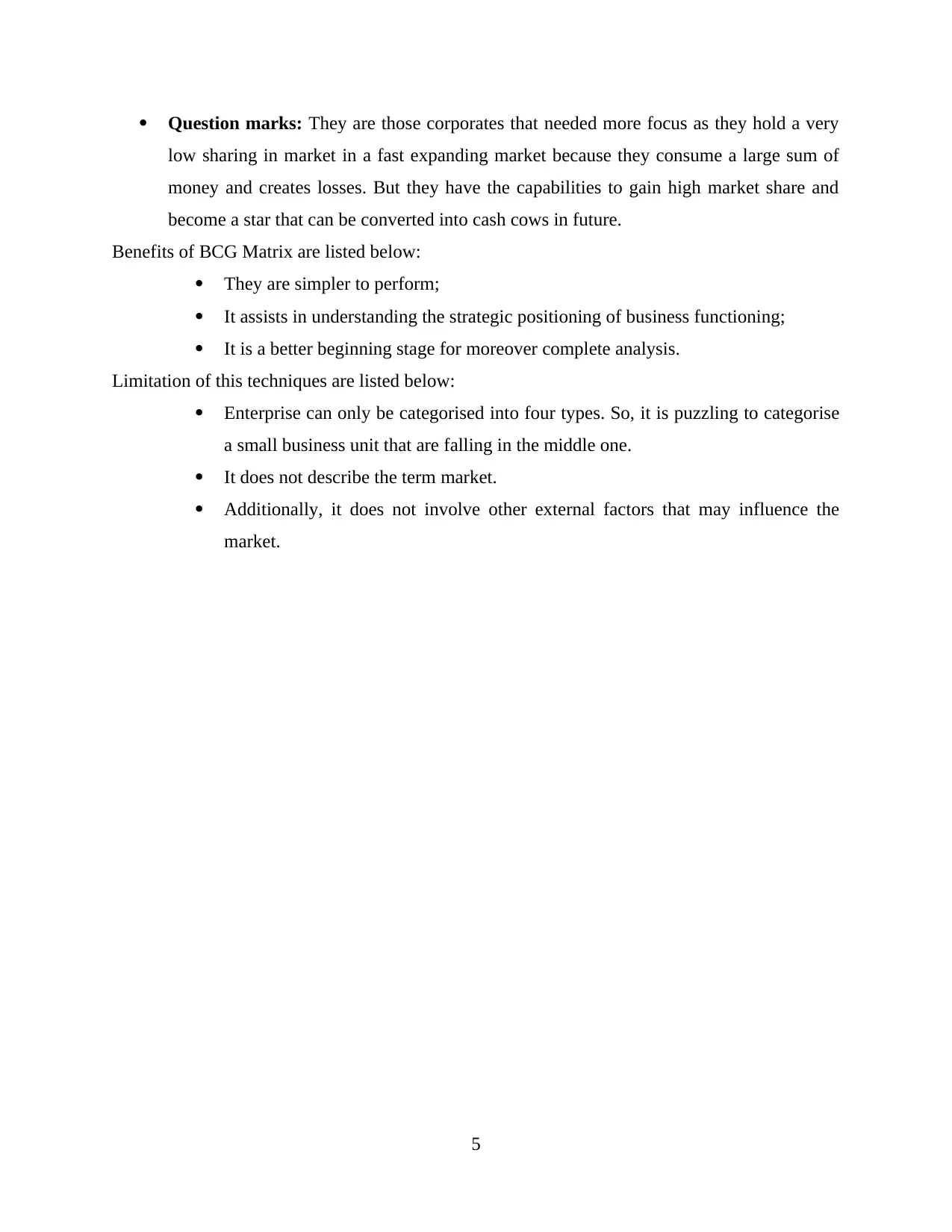
Question marks: They are those corporates that needed more focus as they hold a very
low sharing in market in a fast expanding market because they consume a large sum of
money and creates losses. But they have the capabilities to gain high market share and
become a star that can be converted into cash cows in future.
Benefits of BCG Matrix are listed below:
They are simpler to perform;
It assists in understanding the strategic positioning of business functioning;
It is a better beginning stage for moreover complete analysis.
Limitation of this techniques are listed below:
Enterprise can only be categorised into four types. So, it is puzzling to categorise
a small business unit that are falling in the middle one.
It does not describe the term market.
Additionally, it does not involve other external factors that may influence the
market.
5
low sharing in market in a fast expanding market because they consume a large sum of
money and creates losses. But they have the capabilities to gain high market share and
become a star that can be converted into cash cows in future.
Benefits of BCG Matrix are listed below:
They are simpler to perform;
It assists in understanding the strategic positioning of business functioning;
It is a better beginning stage for moreover complete analysis.
Limitation of this techniques are listed below:
Enterprise can only be categorised into four types. So, it is puzzling to categorise
a small business unit that are falling in the middle one.
It does not describe the term market.
Additionally, it does not involve other external factors that may influence the
market.
5
Paraphrase This Document
Need a fresh take? Get an instant paraphrase of this document with our AI Paraphraser
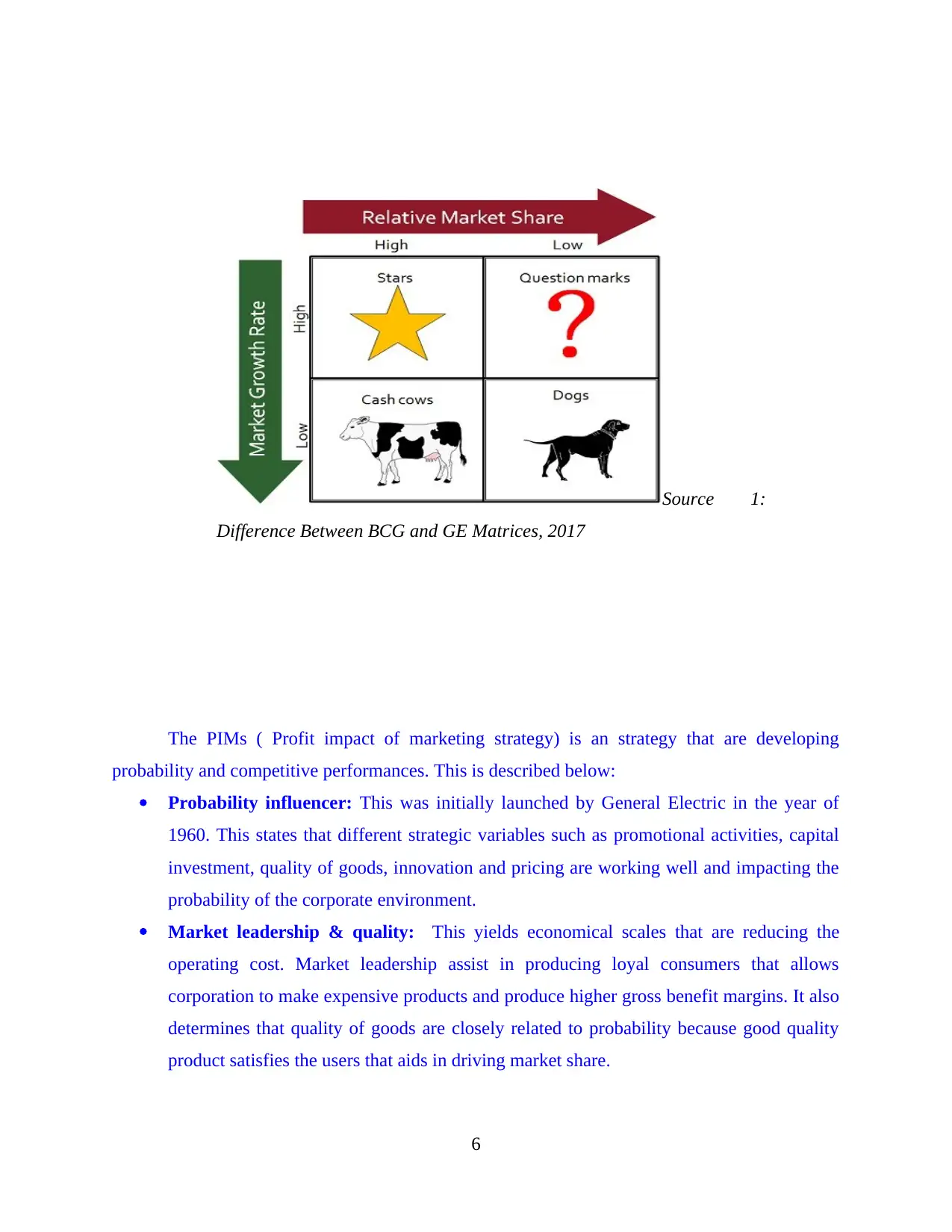
The PIMs ( Profit impact of marketing strategy) is an strategy that are developing
probability and competitive performances. This is described below:
Probability influencer: This was initially launched by General Electric in the year of
1960. This states that different strategic variables such as promotional activities, capital
investment, quality of goods, innovation and pricing are working well and impacting the
probability of the corporate environment.
Market leadership & quality: This yields economical scales that are reducing the
operating cost. Market leadership assist in producing loyal consumers that allows
corporation to make expensive products and produce higher gross benefit margins. It also
determines that quality of goods are closely related to probability because good quality
product satisfies the users that aids in driving market share.
6
Source 1:
Difference Between BCG and GE Matrices, 2017
probability and competitive performances. This is described below:
Probability influencer: This was initially launched by General Electric in the year of
1960. This states that different strategic variables such as promotional activities, capital
investment, quality of goods, innovation and pricing are working well and impacting the
probability of the corporate environment.
Market leadership & quality: This yields economical scales that are reducing the
operating cost. Market leadership assist in producing loyal consumers that allows
corporation to make expensive products and produce higher gross benefit margins. It also
determines that quality of goods are closely related to probability because good quality
product satisfies the users that aids in driving market share.
6
Source 1:
Difference Between BCG and GE Matrices, 2017
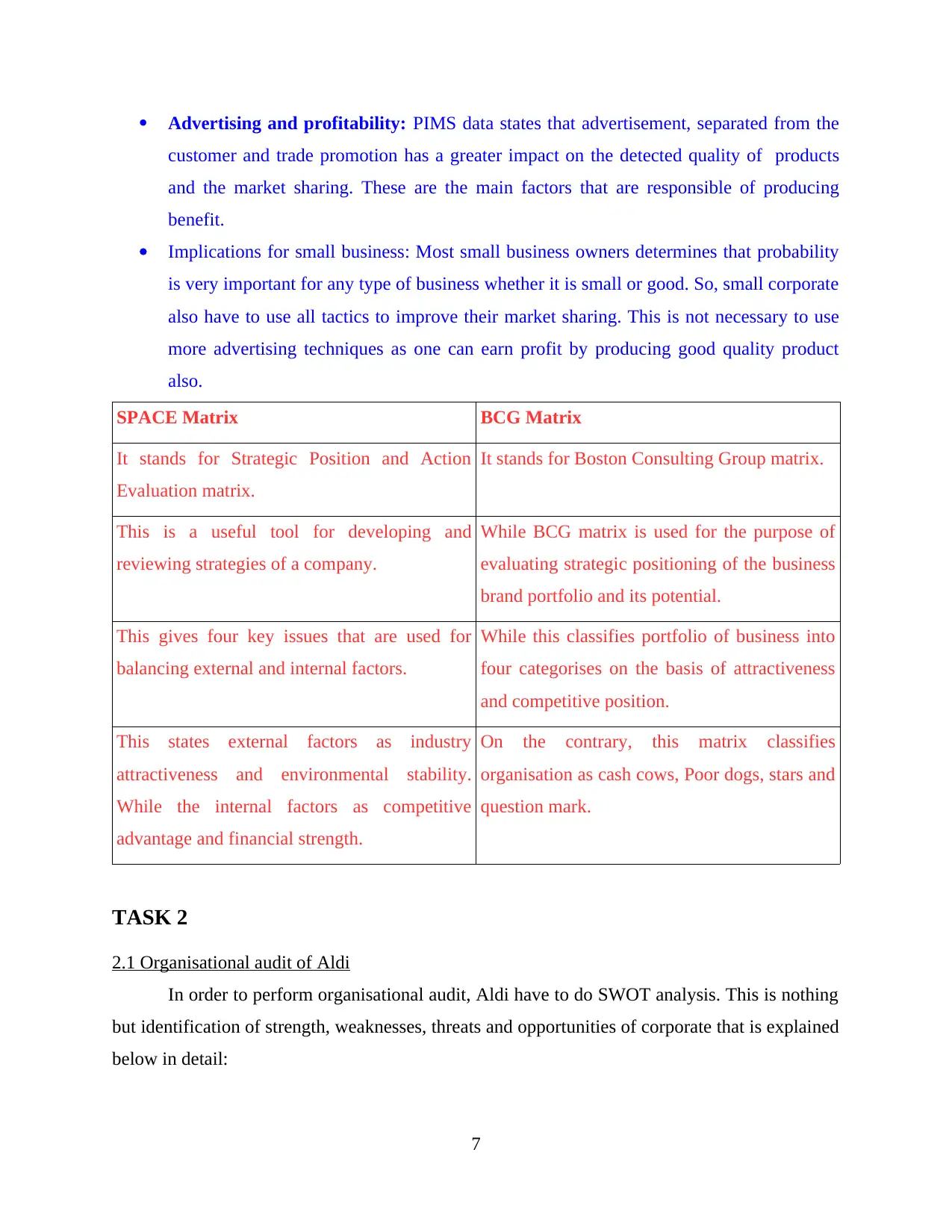
Advertising and profitability: PIMS data states that advertisement, separated from the
customer and trade promotion has a greater impact on the detected quality of products
and the market sharing. These are the main factors that are responsible of producing
benefit.
Implications for small business: Most small business owners determines that probability
is very important for any type of business whether it is small or good. So, small corporate
also have to use all tactics to improve their market sharing. This is not necessary to use
more advertising techniques as one can earn profit by producing good quality product
also.
SPACE Matrix BCG Matrix
It stands for Strategic Position and Action
Evaluation matrix.
It stands for Boston Consulting Group matrix.
This is a useful tool for developing and
reviewing strategies of a company.
While BCG matrix is used for the purpose of
evaluating strategic positioning of the business
brand portfolio and its potential.
This gives four key issues that are used for
balancing external and internal factors.
While this classifies portfolio of business into
four categorises on the basis of attractiveness
and competitive position.
This states external factors as industry
attractiveness and environmental stability.
While the internal factors as competitive
advantage and financial strength.
On the contrary, this matrix classifies
organisation as cash cows, Poor dogs, stars and
question mark.
TASK 2
2.1 Organisational audit of Aldi
In order to perform organisational audit, Aldi have to do SWOT analysis. This is nothing
but identification of strength, weaknesses, threats and opportunities of corporate that is explained
below in detail:
7
customer and trade promotion has a greater impact on the detected quality of products
and the market sharing. These are the main factors that are responsible of producing
benefit.
Implications for small business: Most small business owners determines that probability
is very important for any type of business whether it is small or good. So, small corporate
also have to use all tactics to improve their market sharing. This is not necessary to use
more advertising techniques as one can earn profit by producing good quality product
also.
SPACE Matrix BCG Matrix
It stands for Strategic Position and Action
Evaluation matrix.
It stands for Boston Consulting Group matrix.
This is a useful tool for developing and
reviewing strategies of a company.
While BCG matrix is used for the purpose of
evaluating strategic positioning of the business
brand portfolio and its potential.
This gives four key issues that are used for
balancing external and internal factors.
While this classifies portfolio of business into
four categorises on the basis of attractiveness
and competitive position.
This states external factors as industry
attractiveness and environmental stability.
While the internal factors as competitive
advantage and financial strength.
On the contrary, this matrix classifies
organisation as cash cows, Poor dogs, stars and
question mark.
TASK 2
2.1 Organisational audit of Aldi
In order to perform organisational audit, Aldi have to do SWOT analysis. This is nothing
but identification of strength, weaknesses, threats and opportunities of corporate that is explained
below in detail:
7
⊘ This is a preview!⊘
Do you want full access?
Subscribe today to unlock all pages.

Trusted by 1+ million students worldwide
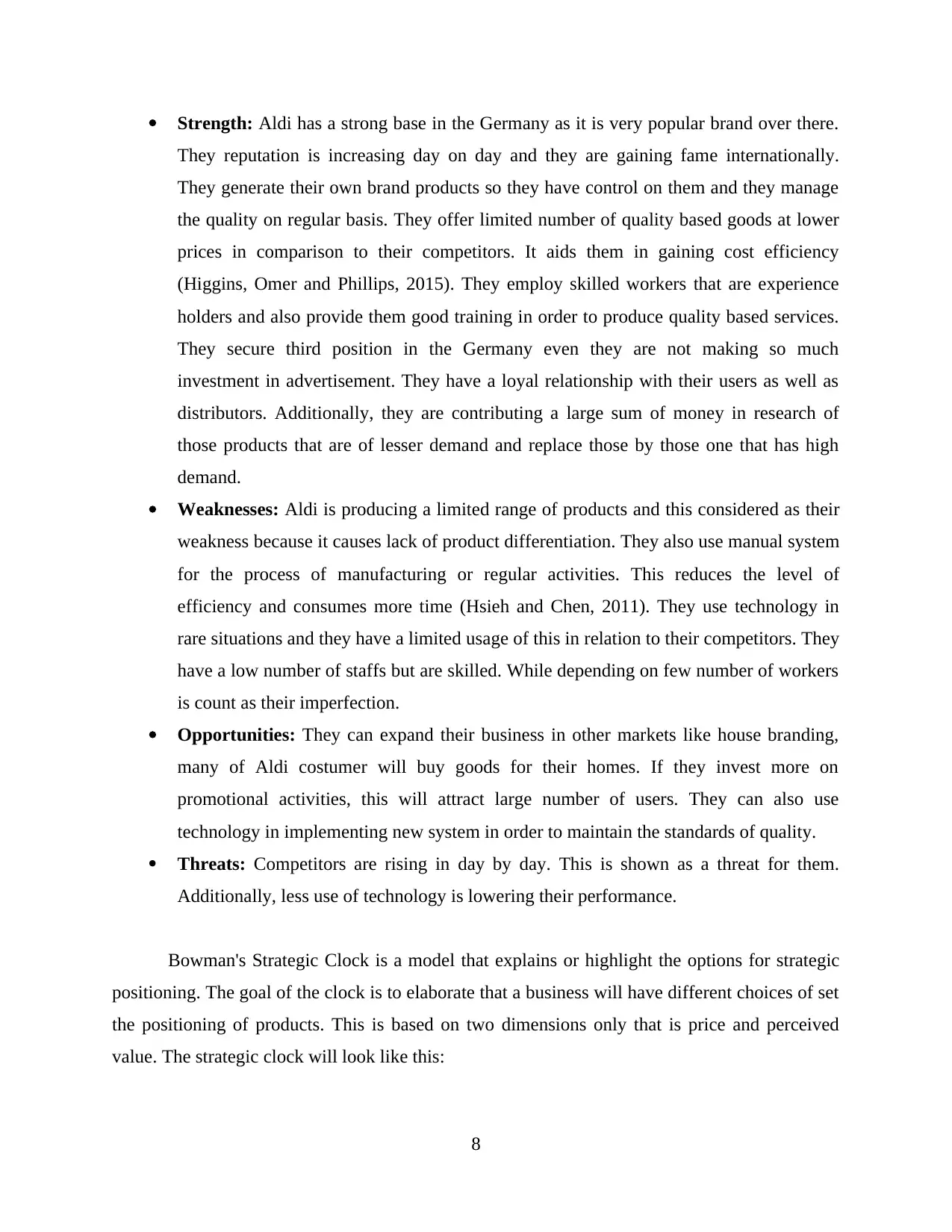
Strength: Aldi has a strong base in the Germany as it is very popular brand over there.
They reputation is increasing day on day and they are gaining fame internationally.
They generate their own brand products so they have control on them and they manage
the quality on regular basis. They offer limited number of quality based goods at lower
prices in comparison to their competitors. It aids them in gaining cost efficiency
(Higgins, Omer and Phillips, 2015). They employ skilled workers that are experience
holders and also provide them good training in order to produce quality based services.
They secure third position in the Germany even they are not making so much
investment in advertisement. They have a loyal relationship with their users as well as
distributors. Additionally, they are contributing a large sum of money in research of
those products that are of lesser demand and replace those by those one that has high
demand.
Weaknesses: Aldi is producing a limited range of products and this considered as their
weakness because it causes lack of product differentiation. They also use manual system
for the process of manufacturing or regular activities. This reduces the level of
efficiency and consumes more time (Hsieh and Chen, 2011). They use technology in
rare situations and they have a limited usage of this in relation to their competitors. They
have a low number of staffs but are skilled. While depending on few number of workers
is count as their imperfection.
Opportunities: They can expand their business in other markets like house branding,
many of Aldi costumer will buy goods for their homes. If they invest more on
promotional activities, this will attract large number of users. They can also use
technology in implementing new system in order to maintain the standards of quality.
Threats: Competitors are rising in day by day. This is shown as a threat for them.
Additionally, less use of technology is lowering their performance.
Bowman's Strategic Clock is a model that explains or highlight the options for strategic
positioning. The goal of the clock is to elaborate that a business will have different choices of set
the positioning of products. This is based on two dimensions only that is price and perceived
value. The strategic clock will look like this:
8
They reputation is increasing day on day and they are gaining fame internationally.
They generate their own brand products so they have control on them and they manage
the quality on regular basis. They offer limited number of quality based goods at lower
prices in comparison to their competitors. It aids them in gaining cost efficiency
(Higgins, Omer and Phillips, 2015). They employ skilled workers that are experience
holders and also provide them good training in order to produce quality based services.
They secure third position in the Germany even they are not making so much
investment in advertisement. They have a loyal relationship with their users as well as
distributors. Additionally, they are contributing a large sum of money in research of
those products that are of lesser demand and replace those by those one that has high
demand.
Weaknesses: Aldi is producing a limited range of products and this considered as their
weakness because it causes lack of product differentiation. They also use manual system
for the process of manufacturing or regular activities. This reduces the level of
efficiency and consumes more time (Hsieh and Chen, 2011). They use technology in
rare situations and they have a limited usage of this in relation to their competitors. They
have a low number of staffs but are skilled. While depending on few number of workers
is count as their imperfection.
Opportunities: They can expand their business in other markets like house branding,
many of Aldi costumer will buy goods for their homes. If they invest more on
promotional activities, this will attract large number of users. They can also use
technology in implementing new system in order to maintain the standards of quality.
Threats: Competitors are rising in day by day. This is shown as a threat for them.
Additionally, less use of technology is lowering their performance.
Bowman's Strategic Clock is a model that explains or highlight the options for strategic
positioning. The goal of the clock is to elaborate that a business will have different choices of set
the positioning of products. This is based on two dimensions only that is price and perceived
value. The strategic clock will look like this:
8
Paraphrase This Document
Need a fresh take? Get an instant paraphrase of this document with our AI Paraphraser
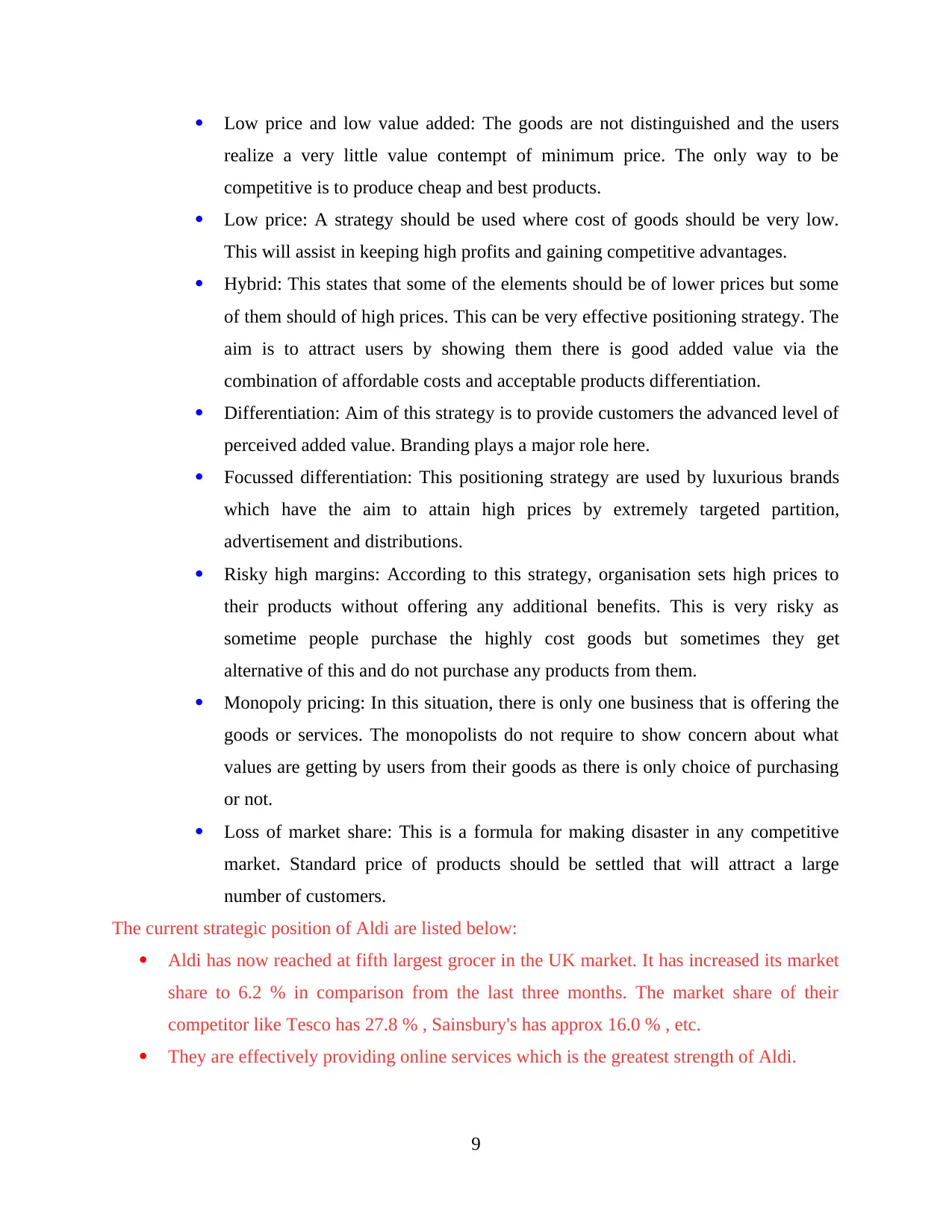
Low price and low value added: The goods are not distinguished and the users
realize a very little value contempt of minimum price. The only way to be
competitive is to produce cheap and best products.
Low price: A strategy should be used where cost of goods should be very low.
This will assist in keeping high profits and gaining competitive advantages.
Hybrid: This states that some of the elements should be of lower prices but some
of them should of high prices. This can be very effective positioning strategy. The
aim is to attract users by showing them there is good added value via the
combination of affordable costs and acceptable products differentiation.
Differentiation: Aim of this strategy is to provide customers the advanced level of
perceived added value. Branding plays a major role here.
Focussed differentiation: This positioning strategy are used by luxurious brands
which have the aim to attain high prices by extremely targeted partition,
advertisement and distributions.
Risky high margins: According to this strategy, organisation sets high prices to
their products without offering any additional benefits. This is very risky as
sometime people purchase the highly cost goods but sometimes they get
alternative of this and do not purchase any products from them.
Monopoly pricing: In this situation, there is only one business that is offering the
goods or services. The monopolists do not require to show concern about what
values are getting by users from their goods as there is only choice of purchasing
or not.
Loss of market share: This is a formula for making disaster in any competitive
market. Standard price of products should be settled that will attract a large
number of customers.
The current strategic position of Aldi are listed below:
Aldi has now reached at fifth largest grocer in the UK market. It has increased its market
share to 6.2 % in comparison from the last three months. The market share of their
competitor like Tesco has 27.8 % , Sainsbury's has approx 16.0 % , etc.
They are effectively providing online services which is the greatest strength of Aldi.
9
realize a very little value contempt of minimum price. The only way to be
competitive is to produce cheap and best products.
Low price: A strategy should be used where cost of goods should be very low.
This will assist in keeping high profits and gaining competitive advantages.
Hybrid: This states that some of the elements should be of lower prices but some
of them should of high prices. This can be very effective positioning strategy. The
aim is to attract users by showing them there is good added value via the
combination of affordable costs and acceptable products differentiation.
Differentiation: Aim of this strategy is to provide customers the advanced level of
perceived added value. Branding plays a major role here.
Focussed differentiation: This positioning strategy are used by luxurious brands
which have the aim to attain high prices by extremely targeted partition,
advertisement and distributions.
Risky high margins: According to this strategy, organisation sets high prices to
their products without offering any additional benefits. This is very risky as
sometime people purchase the highly cost goods but sometimes they get
alternative of this and do not purchase any products from them.
Monopoly pricing: In this situation, there is only one business that is offering the
goods or services. The monopolists do not require to show concern about what
values are getting by users from their goods as there is only choice of purchasing
or not.
Loss of market share: This is a formula for making disaster in any competitive
market. Standard price of products should be settled that will attract a large
number of customers.
The current strategic position of Aldi are listed below:
Aldi has now reached at fifth largest grocer in the UK market. It has increased its market
share to 6.2 % in comparison from the last three months. The market share of their
competitor like Tesco has 27.8 % , Sainsbury's has approx 16.0 % , etc.
They are effectively providing online services which is the greatest strength of Aldi.
9
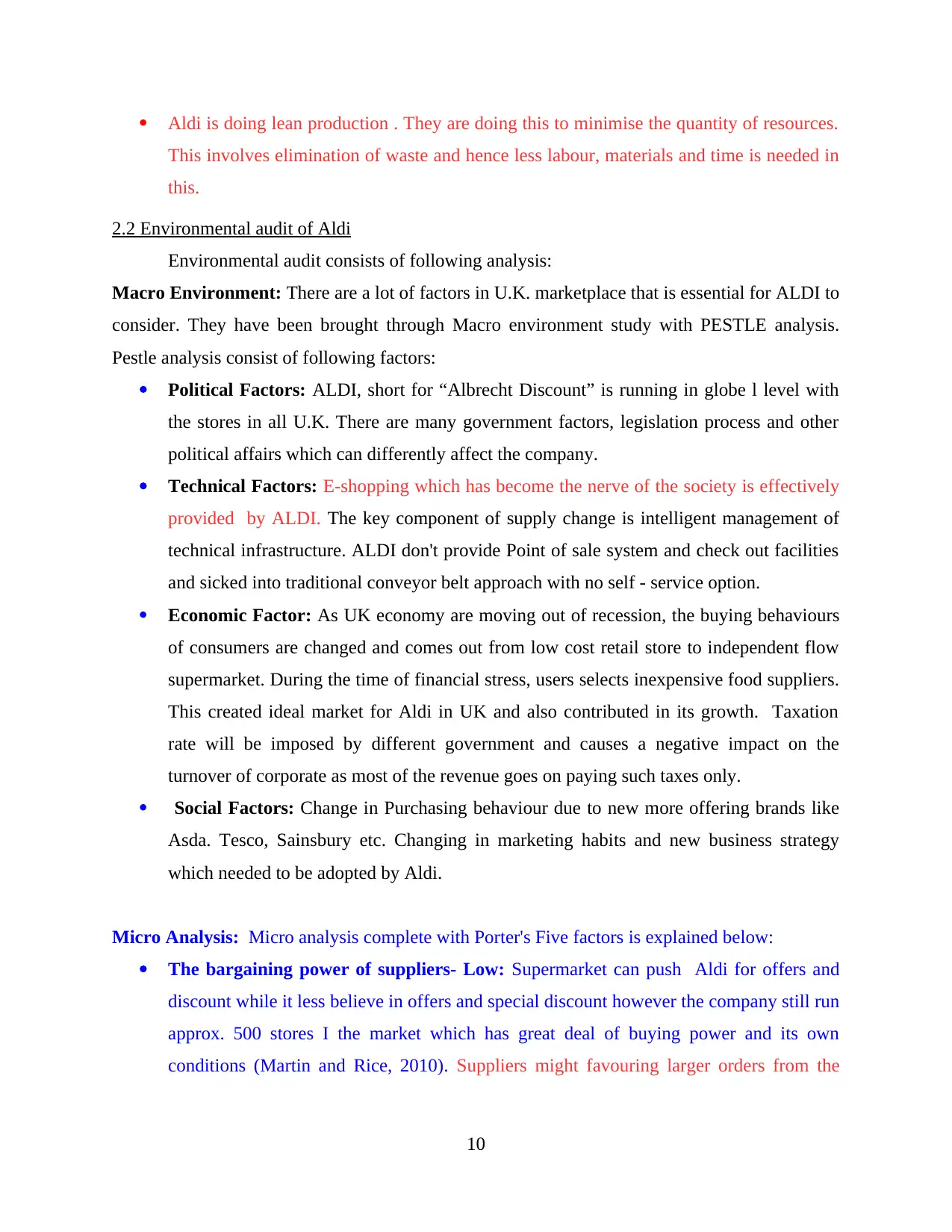
Aldi is doing lean production . They are doing this to minimise the quantity of resources.
This involves elimination of waste and hence less labour, materials and time is needed in
this.
2.2 Environmental audit of Aldi
Environmental audit consists of following analysis:
Macro Environment: There are a lot of factors in U.K. marketplace that is essential for ALDI to
consider. They have been brought through Macro environment study with PESTLE analysis.
Pestle analysis consist of following factors:
Political Factors: ALDI, short for “Albrecht Discount” is running in globe l level with
the stores in all U.K. There are many government factors, legislation process and other
political affairs which can differently affect the company.
Technical Factors: E-shopping which has become the nerve of the society is effectively
provided by ALDI. The key component of supply change is intelligent management of
technical infrastructure. ALDI don't provide Point of sale system and check out facilities
and sicked into traditional conveyor belt approach with no self - service option.
Economic Factor: As UK economy are moving out of recession, the buying behaviours
of consumers are changed and comes out from low cost retail store to independent flow
supermarket. During the time of financial stress, users selects inexpensive food suppliers.
This created ideal market for Aldi in UK and also contributed in its growth. Taxation
rate will be imposed by different government and causes a negative impact on the
turnover of corporate as most of the revenue goes on paying such taxes only.
Social Factors: Change in Purchasing behaviour due to new more offering brands like
Asda. Tesco, Sainsbury etc. Changing in marketing habits and new business strategy
which needed to be adopted by Aldi.
Micro Analysis: Micro analysis complete with Porter's Five factors is explained below:
The bargaining power of suppliers- Low: Supermarket can push Aldi for offers and
discount while it less believe in offers and special discount however the company still run
approx. 500 stores I the market which has great deal of buying power and its own
conditions (Martin and Rice, 2010). Suppliers might favouring larger orders from the
10
This involves elimination of waste and hence less labour, materials and time is needed in
this.
2.2 Environmental audit of Aldi
Environmental audit consists of following analysis:
Macro Environment: There are a lot of factors in U.K. marketplace that is essential for ALDI to
consider. They have been brought through Macro environment study with PESTLE analysis.
Pestle analysis consist of following factors:
Political Factors: ALDI, short for “Albrecht Discount” is running in globe l level with
the stores in all U.K. There are many government factors, legislation process and other
political affairs which can differently affect the company.
Technical Factors: E-shopping which has become the nerve of the society is effectively
provided by ALDI. The key component of supply change is intelligent management of
technical infrastructure. ALDI don't provide Point of sale system and check out facilities
and sicked into traditional conveyor belt approach with no self - service option.
Economic Factor: As UK economy are moving out of recession, the buying behaviours
of consumers are changed and comes out from low cost retail store to independent flow
supermarket. During the time of financial stress, users selects inexpensive food suppliers.
This created ideal market for Aldi in UK and also contributed in its growth. Taxation
rate will be imposed by different government and causes a negative impact on the
turnover of corporate as most of the revenue goes on paying such taxes only.
Social Factors: Change in Purchasing behaviour due to new more offering brands like
Asda. Tesco, Sainsbury etc. Changing in marketing habits and new business strategy
which needed to be adopted by Aldi.
Micro Analysis: Micro analysis complete with Porter's Five factors is explained below:
The bargaining power of suppliers- Low: Supermarket can push Aldi for offers and
discount while it less believe in offers and special discount however the company still run
approx. 500 stores I the market which has great deal of buying power and its own
conditions (Martin and Rice, 2010). Suppliers might favouring larger orders from the
10
⊘ This is a preview!⊘
Do you want full access?
Subscribe today to unlock all pages.

Trusted by 1+ million students worldwide
1 out of 26
Related Documents
Your All-in-One AI-Powered Toolkit for Academic Success.
+13062052269
info@desklib.com
Available 24*7 on WhatsApp / Email
![[object Object]](/_next/static/media/star-bottom.7253800d.svg)
Unlock your academic potential
Copyright © 2020–2025 A2Z Services. All Rights Reserved. Developed and managed by ZUCOL.





